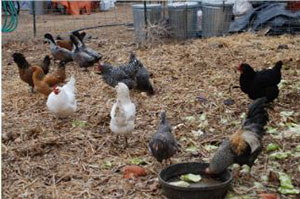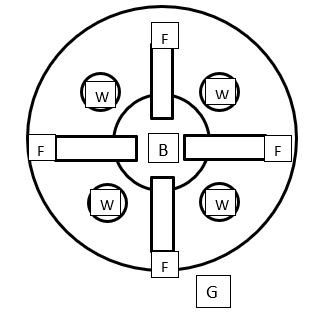by Howard Enos* (3/20)
Quick Facts…
- Chick selection is the first step to developing your family flock. It is recommended to buy quality chicks from a reliable hatchery.
- Chick breeds fall into three categories: egg production, meat production or dual breeds for both eggs and meat production.
- Poultry housing requires adequate space, a reliable heat source and proper ventilation.
- Chicks should be placed in a clean, disinfected poultry house with equipment and utensils that have also been cleaned and disinfected.
- You may be able to purchase debeaked chicks as this could prevent cannibalism among confined birds.

Chicks should be purchased to fit the needs of the family that will be using them. The first consideration when purchasing the chicks is finding a reliable seller who provides quality chicks with dependable information and customer service. You may purchase fertilized eggs if you have access to a reliable incubator. However, this increases the time to have hens old enough for egg production (21-day incubation period).
If only egg production is desired, sexed Leghorn pullets or egg laying breeds are recommended. White Plymouth Rocks or broiler crosses are popular meat production birds. Dual-purpose breeds are available for those interested in both egg and meat production, although these generally will not lay as well as egg laying breeds.
Chicks should be placed in a clean, disinfected poultry house with equipment and utensils that have been cleaned and disinfected. They should be watched closely for the first few days and nights to ensure comfort, cleanliness and proper temperature control. Setting up the brooder before the chicks arrive provides valuable time to check the operation and ensure correct function. It is also important to provide food and clean water daily.
The normal brooding period when heat is required is about six to eight weeks. There are many places on the property where chicks may be brooded. The main requirements are 1) adequate space, 2) reliable source of heat (brooder), and 3) proper ventilation.
Brooders
The most popular brooders are infrared heat lamps, and propane catalytic and gas brooders. The choice among infrared heat lamps, propane catalytic and gas brooders depends on convenience, installation cost and operating costs.
The infrared heat lamp (Pyrex-type) is ideal for brooding small litters of 200 chicks or less. The lamp should be equipped with a porcelain socket, lamp guard and at least No. 16 heavy insulation wire. One 250-watt lamp should be provided for each 50 to 75 chicks. Watch for signs of overheating – chicks trying to stay against the brooder edge where it is cooler, and chills – chicks huddling or piling under the center most part of the brooder lamp.
Propane or natural gas brooders are very reliable and are economical if gas is used elsewhere on the farm and is purchased in sizable volume. The main advantage of the catalytic brooder is that it is flameless and almost 100 percent efficient.
Before Chicks Arrive
Before a new flock of chicks is placed in the poultry house, all old litter should be removed. The ceiling, walls and floor of the house should be cleaned and disinfected. It is best if the house can be left empty for at least 2 weeks prior to restocking. The house should be thoroughly dry before new litter is put down. All equipment; including feeders, waterers and brooders, should be cleaned and disinfected.
Repairs should be made to windows, doors, ventilators or any part of the brooder house that needs attention. All drafts should be eliminated. The floor should be covered with 3 to 4 inches (8-10 centimeters) of dry litter. Litter may be shavings, sawdust or other material that is readily available. Consider products that are economical and provide good moisture absorbency.
Birds near the brooder should be confined with a chick guard – a circular fence about 18 inches (46 centimeters) high (see Figure 1). Some people cover the litter for the first few days of brooding. If this is done, rough, crinkled paper should be used. Smooth paper causes chicks to slip and develop spraddled legs. Molds will develop if the paper is left on the litter more than three to four days. The guard should be removed after seven days.
All equipment should be checked to be sure that it is working properly. Operate brooder heaters for at least 24 hours before the chicks arrive. This will warm and dry the house and demonstrate the accuracy of brooder controls and thermostats.
Feed can be put out and the waterers filled a few hours before the chicks arrive. When the chicks arrive, the house must be ready for them.
Management of Chicks
After the chicks have been placed in the brooder area, the brooder heater should be adjusted to 90-95°F (32-35°C), measured two inches (5 centimeters) above the litter at the edge of the hover. This temperature should be maintained for the first week. The temperature then is reduced five degrees each week until 70°F (21°C) is reached.
Watch chicks closely for the first few days and nights to be sure that they are comfortable. They will crowd under the hover if they are too cold and away from the hover if they are too warm.
If infrared lamps are used, raise the lamps when chicks appear to be too warm. Normally, lamps should be set at 18-inch (46 centimeters) height the first week and should be raised three inches (8 centimeters) each week.
Chicks should be provided with plenty of fresh air. The house should not be closed tightly to keep it warm. Air ventilation is used to carry moisture out of the house as well as provide fresh air for the chicks. The floor will be dryer and the chicks healthier when proper ventilation is provided.
Litter should be kept dry. This is important to prevent coccidiosis and other diseases. Frequent stirring of litter helps keep it dry. Adding some hydrated lime to the litter also will help keep it dry.
A 15-watt bulb for each 200 square feet (18 square meters) of floor area should be kept on at night for the first week. Thereafter, the lighting system to use depends on the type of building. Any system that provides a maximum of 14 hours total light per day during the entire brooding and growing period should give satisfactory results. Due to dust and the curious nature of chickens, lamps can be a fire hazard. Take care to clean dust build up off the bulb and keep the bulb and cord out of reach or enclose the cord in metal conduit to protect birds.
Roosts are not used for broilers but are for layers and layer replacement chicks. Install low roosts when chicks are four to six weeks of age to provide each chick with four inches (10 centimeters) of roost space.
Feed and Water Management
Waterers must be cleaned frequently and placed on slatted or wire platforms so that birds will be kept away from wet floor areas. Feed wastage can be prevented by filling feeders only one-third to one-half full.
For the first six weeks, the chicks should be fed a 20- to 22-percent protein starter mash; then an all-mash ration that is a 16- or 20-percent protein grower mash, plus an equal amount of grain. The starter mash may contain an antibiotic at high level for the first 10 days to help chicks get a good start.
A coccidiostat (a drug used to control the disease, coccidiosis) should be used in ration continuously throughout the growing period. About nine pounds (900 pounds or 408 kilograms per 100 birds) of feed per one bird is needed for the first eight weeks.
Cannibalism
Confined birds are subject to cannibalism. If possible, buy chicks that have been debeaked at the hatchery. Watch for early signs of feather picking, and debeak the birds before cannibalism becomes an established habit. Cull birds that have a tendency toward cannibalism. Providing plenty of space and physical stimulation can help reduce cannibalism.
Protecting the Flock
Young chicks and growing birds should be protected and isolated from other animals and birds. Cats, rodents and numerous wild animals will kill young chickens. These animals can spread diseases and parasites. They can contaminate and consume large amounts of poultry feed while being destructive to the building.
The following floor space is recommended.
| Age of chicks | Floor space/bird |
| 0-4 weeks | 1/2 square foot (0.05 square meter) |
| 4-8 weeks | 1 square foot (0.09 square meter) |
| 8-12 weeks | 2 square feet (0.18 square meter) |
| 12 weeks or older | 2 1/2 – 3 square feet (0.23-0.27 square meter) light breeds 3 – 3 1/2 square feet (0.27-0.32 square meter) heavey breeds |
| Example: A 2X3 foot (0.6X1.0 meter) brooder house will take care of 6 chicks up to eight weeks of age. A 10X12-foot (3X3.7-meter) brooder house will take care of 120 chicks up to eight weeks of age. |
|

Figure 1: Brooder arrangement.
B – Brooder stove with hover.
F – Feeders arranged in spoke-like fashion.
W – Waterers (quart size).
G – Chick guard 18” (46 cm) high arranged in 4-6 foot (1.2 – 1.8 meter) diameter circle around brooder.
Feeder Space
The amount of linear feeder space recommended per 10 chicks (space for 100 chicks noted in parenthesis):
| Age of chicks | Feeder space |
| 0-4 weeks | 1.2 linear feet (12 linear feet* or two 3-foot feeders) |
| 4-8 weeks | 2 linear feet (20 linear feet or two 5-foot feeders) |
| 8-12 weeks | 3 linear feet (30 linear feet or three 5-foot feeders) |
| 12 weeks and older | 4 linear feet (40 linear feet or four 5-foot feeders) |
*To convert to metrics, use the following conversion: 1 foot = 0.3 meters.
Waterer Space
The amount of waterer space recommended per 10 chicks (space for 100 chicks noted in parenthesis):
| Age of chicks | Feeder space |
| 0-1 week | One 1-quart jar waterer (Six 1-quart* jar waterers) |
| 1-4 weeks | Two 1-quart jar waterers (Two 2-gallon waterers) |
| 4-12 weeks | One 1-gallon waterer (Two 5-gallon waterers) |
Automatic waterers may be used after the first week.
*To convert to metrics, use the following conversions: 1 quart=0.95 liter; 1 gallon=3.8 liters.
*Howard Enos, CSU Extension Associate Professor, Poultry Science, Robin Young, Archuleta County Director; Travis Hoesli, Grand County Director; Todd Hagenbuch, Routt County Director; Sharon Bokan, Small Acreage Coordinator Boulder County Extension. 1/74. Revised 3/20.





